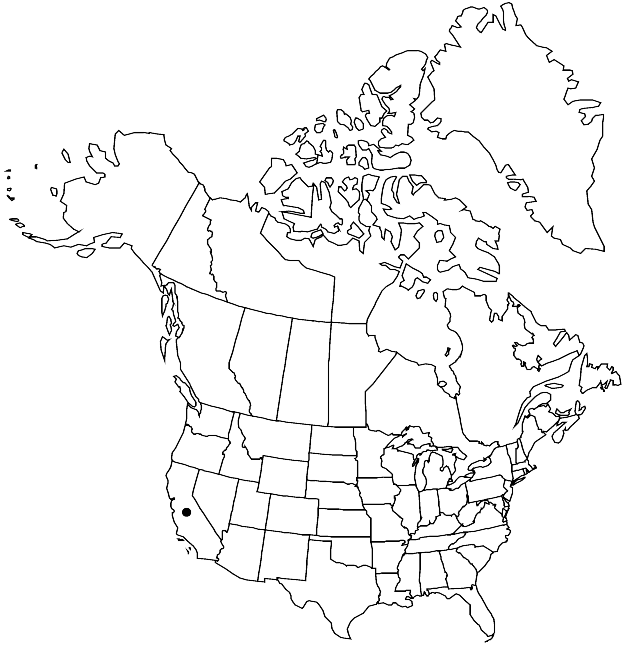Difference between revisions of "Gemmabryum californicum"
Phytologia 89: 111. 2007.
FNA>Volume Importer |
FNA>Volume Importer |
||
| Line 30: | Line 30: | ||
|elevation=low to moderate elevations (0-600 m) | |elevation=low to moderate elevations (0-600 m) | ||
|distribution=Calif. | |distribution=Calif. | ||
| − | |discussion=<p>Gemmabryum californicum is a remarkable species endemic to the central coast of California that produces the smallest known bulbils in the family. The bulbils can be so numerous that they obscure the distal portion of the stem as a dull to bright green powdery mass. The tiny bulbils appear to be released at this stage, and appear to arise from axillary hairs. If confirmed, this would be a new form of specialized asexual reproductive structure based on origin and development for the family. The species is very similar to G. dichotomum, and only separable by its bulbils and somewhat more triangular-shaped leaves. In southern and central California there are small strongly imbricate gemmiform plants with a short stout costa, strongly concave leaves, incrassate distal laminal cells, no bulbils, and an elongate-cylindric capsule that represent an undescribed species. Gemmabryum californicum could occur northward in Mediterranean climates to southwestern British Columbia.</p> | + | |discussion=<p><i>Gemmabryum californicum</i> is a remarkable species endemic to the central coast of California that produces the smallest known bulbils in the family. The bulbils can be so numerous that they obscure the distal portion of the stem as a dull to bright green powdery mass. The tiny bulbils appear to be released at this stage, and appear to arise from axillary hairs. If confirmed, this would be a new form of specialized asexual reproductive structure based on origin and development for the family. The species is very similar to <i>G. dichotomum</i>, and only separable by its bulbils and somewhat more triangular-shaped leaves. In southern and central California there are small strongly imbricate gemmiform plants with a short stout costa, strongly concave leaves, incrassate distal laminal cells, no bulbils, and an elongate-cylindric capsule that represent an undescribed species. <i>Gemmabryum californicum</i> could occur northward in Mediterranean climates to southwestern British Columbia.</p> |
|tables= | |tables= | ||
|references= | |references= | ||
| Line 54: | Line 54: | ||
|publication year=2007 | |publication year=2007 | ||
|special status=Endemic | |special status=Endemic | ||
| − | |source xml=https://jpend@bitbucket.org/aafc-mbb/fna-data-curation.git/src/ | + | |source xml=https://jpend@bitbucket.org/aafc-mbb/fna-data-curation.git/src/8f726806613d60c220dc4493de13607dd3150896/coarse_grained_fna_xml/V28/V28_209.xml |
|genus=Gemmabryum | |genus=Gemmabryum | ||
|section=Gemmabryum sect. Gemmabryum | |section=Gemmabryum sect. Gemmabryum | ||
Revision as of 17:03, 18 September 2019
Plants yellow-green to golden. Stems 0.1–1 cm, gemmiform. Leaves ovate to triangular, strongly concave, 0.5–1.5(–2) mm; margins plane to revolute proximally; apex acute to acuminate; costa percurrent to short-excurrent; proximal laminal cells abruptly quadrate to short-rectangular, 1–2:1; medial and distal cells 8–12(–16) µm wide, 3–4:1. Specialized asexual reproduction by leaf axil bulbils, bulbils many (more than 25), variously shaped, often obconic or keyhole-shaped, (40–)50–70 µm, primordia absent or very short and peglike, in (2–)3(–4) tiers with 1 cell in first tier, 2 in second tier, and 4–6 in distal tier with longitudinal and transverse red or green septa. Capsule nutant, red to red-brown at maturity, 1–2(–3) mm; hypophysis thickened, not inflated, not or weakly rugose; peristome well developed; endostome not adherent to exostome, basal membrane high, segments well developed, perforations ovate, cilia long, appendiculate.
Phenology: Capsules mature Apr–Jul (spring–summer).
Habitat: Dry to damp soil, rock, sometimes calcareous, sandstone
Elevation: low to moderate elevations (0-600 m)
Discussion
Gemmabryum californicum is a remarkable species endemic to the central coast of California that produces the smallest known bulbils in the family. The bulbils can be so numerous that they obscure the distal portion of the stem as a dull to bright green powdery mass. The tiny bulbils appear to be released at this stage, and appear to arise from axillary hairs. If confirmed, this would be a new form of specialized asexual reproductive structure based on origin and development for the family. The species is very similar to G. dichotomum, and only separable by its bulbils and somewhat more triangular-shaped leaves. In southern and central California there are small strongly imbricate gemmiform plants with a short stout costa, strongly concave leaves, incrassate distal laminal cells, no bulbils, and an elongate-cylindric capsule that represent an undescribed species. Gemmabryum californicum could occur northward in Mediterranean climates to southwestern British Columbia.
Selected References
None.
